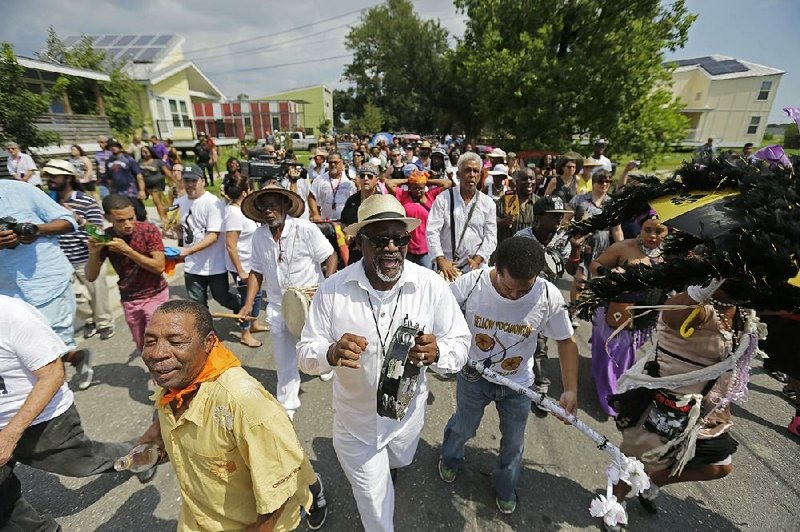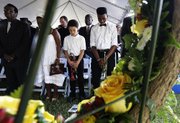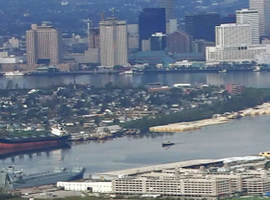NEW ORLEANS -- As church bells rang to mark a decade since Hurricane Katrina struck the Gulf Coast, an 80-year-old woman wept softly into a tissue.
"I feel guilty," said Eloise Allen, whose New Orleans home was damaged but inhabitable after the storm. "I didn't go through what all the other people did."
Saturday was a day to remember what "all the other people" went through: those who were rescued from rooftops by helicopters; those who returned home to find only concrete steps where their houses used to be; those whose bodies were never claimed after the storm.
But the mourning Saturday was balanced by a celebration of how far the region has come since Hurricane Katrina.
Katrina made landfall Aug. 29, 2005. Shortly after, the levees around New Orleans broke and water inundated most of the city.
The storm killed more than 1,800 people and caused $151 billion in damage. It was one of the nation's most deadly, most costly natural disasters. The storm's dead were not far from anyone's thoughts Saturday.
In Mississippi, church bells rang to mark when the storm made landfall. In New Orleans, people gathered at a memorial for the people whose bodies were never claimed or never identified after the storm.
New Orleans Mayor Mitch Landrieu spoke of the dark days after the storm and how the city's residents leaned on one another for support.
"We saved each other," the mayor said. "New Orleans will be unbowed and unbroken."
In Biloxi, Miss., clergy and community leaders gathered at a newly built minor league baseball park to remember Katrina's victims. That evening, the park hosted a concert to celebrate the region's post-storm recovery.
During a prayer service at a seaside park in Gulfport, former Mississippi Gov. Haley Barbour praised volunteers who worked on the Katrina recovery. He said more than 954,000 people from around the nation flocked to Mississippi to pitch in and help in the first five years after the storm, and many of them were motivated by faith.
"They thought it was God's command to try to help people in need," Barbour said.
Katrina caused a storm surge that devastated Mississippi's coast, pushed boats far inland and wiped houses off the map.
Glitzy casinos and condominium towers have been rebuilt in some places. But in others, overgrown lots and empty slabs speak to a slow recovery.
In New Orleans, failures in the levee system put 80 percent of the city underwater.
The city has framed Katrina's 10th anniversary as way to demonstrate to the world how far it has come. In the days after the storm, some questioned whether rebuilding New Orleans should even be attempted.
Last week, the city held art exhibits, dinners, panel discussions and lectures, in which it talked about what the past 10 years have been about, without arriving at any real consensus. There have been city-sanctioned talks about the recovery as "a model for urban America," and meetings about "the capitalist crimes inflicted on New Orleans' working class."
The official anniversary commemoration had its own logo, its own color scheme and its own buzzword: resilience. The message from many civic and business leaders was that the city is better than ever, or at least on track to be.
But, although many parts of the city have rebounded, residents -- particularly in the black community -- still struggle.
"I think a lot of people have been kind of hunkering down and feeling ambivalent at best," said Justin Wolfe, a history professor at Tulane University in New Orleans. "It feels like we're this spectacle, and yet in all that spectacle, the horror of so much of what happened, the tribulation but also how many people ended up on the wrong side of that story, that gets lost."
Triumphs, struggles
In New Orleans' Lower Ninth Ward, residents and community activists gathered Saturday at the levee where Katrina's stormwater poured through and submerged the neighborhood.
Once a bastion of black homeownership, it still hasn't regained anywhere near its pre-Katrina population. But a day of events illustrated how attached the residents, who have returned after the storm, are to their community.
After the speeches were done, a parade snaked through the neighborhood. Music played from boom boxes.
Clarence Davis' family home was four blocks from the levee. He evacuated before Katrina hit, and returned to the area after the storm but now lives in the suburbs. He returned to the Ninth Ward on Saturday to catch up with old friends, but he couldn't bring himself to go to the vacant lot where his house used to be.
"The family home is what kept us together, and it's gone," he said.
His family is scattered now in Houston, Atlanta and Louisiana, as are many of his neighbors.
Wilmington Sims watched the parade from his front porch. He helped build his house before Katrina, then had to redo the work after flooding damaged the first floor.
He said the outpouring of support for the city has been "uplifting," but many residents still need help and the Lower Ninth Ward needs economic development.
More than 100 volunteers have worked at the Carl Henderson house over the past few weeks, doing in that time what had not been done in 10 years of inadequate government disaster assistance, contractor fraud, break-ins and continuing bureaucratic nightmares.
"Today is ceiling drywall," said Dani Babon, a 24-year-old site supervisor for the St. Bernard Project, a volunteer group that was started the year after Katrina.
The Henderson family's house on Amelia Street was flooded by 6½ feet of water in the days after Katrina, and Carl Henderson sat in a friend's house and watched bodies float in the streets.
On Saturday, his house was filled with young people measuring, cutting and drilling. Not that different, Babon said, from any other day as the area's rebuilding continues. The Henderson family expects to move back into its home by Thanksgiving.
By Saturday morning, the St. Bernard Project had rebuilt 615 homes in New Orleans, although its leaders emphasize that there is still a very long way to go.
On Saturday night, President Bill Clinton said New Orleans should celebrate its progress since Katrina but also work on recovery for everyone. "Our job is always to form a more perfect union," he said.
Clinton spoke at a free concert and prayer service event at Smoothie King Center in New Orleans. The event featured performances by the city's Rebirth Brass Band, and Big Chief Monk Boudreaux and the Wild Magnolias.
Also at the event, House Democratic leader Nancy Pelosi praised the progress of New Orleans and said the city has taught America what it is to be great.
Neighborhoods across New Orleans held events to commemorate the storm, and thousands of volunteers spread out across the city in a day of community activism.
Multiple parades included a hundreds-strong, second-line parade that featured wave after wave of brass bands and dancing clubs. The parade rolled from the Lower Ninth Ward and down St. Claude Avenue, swelling as people joined along the way.
Pickups towed loudspeakers along behind, activists held up signs and a half-dozen men rode in the median on horseback, one of them occasionally standing in the saddle and dancing. This is how funerals and other somber occasions are marked in New Orleans.
"After pain and sorrow, we get the second-line bands together, and listen to music and celebrate," said Shade Smith, 28, who was stranded for three days by Katrina's floodwaters in an apartment at the St. Bernard public housing project. He was finally rescued by a family rowing past in a boat. "That's just how people reunite after something really sad, to celebrate a tragedy."
Elsewhere around the city Saturday, life went on quietly.
"We work during the week, so this is the day we clean up," said Larry Sambo, 60, who on Saturday morning was washing the family car on a street in Gentilly, a neighborhood that was under 7 feet of water after Katrina.
He and his wife, Arlene, ran through their own brief Katrina commemoration: evacuation, months of moving around the South, three years in a trailer, insufficient rebuilding aid, dishonest plumbers, higher taxes, higher insurance costs and a street full of new neighbors.
"Katrina made things worse for us," Arlene Sambo said. "We take it one day at a time."
As this anniversary ended, the region continued to look to the future. Maggie Carroll, who heads the Broadmoor Improvement Association in New Orleans, said there's a "real challenge" to make sure that the spirit that drove so much of the post-Katrina recovery continues.
"We need to fight the complacency. Our neighborhood still has problems just like New Orleans has problems," she said.
Information for this article was contributed by Rebecca Santana and Kevin McGill of The Associated Press and by Campbell Robertson of The New York Times.
A Section on 08/30/2015


